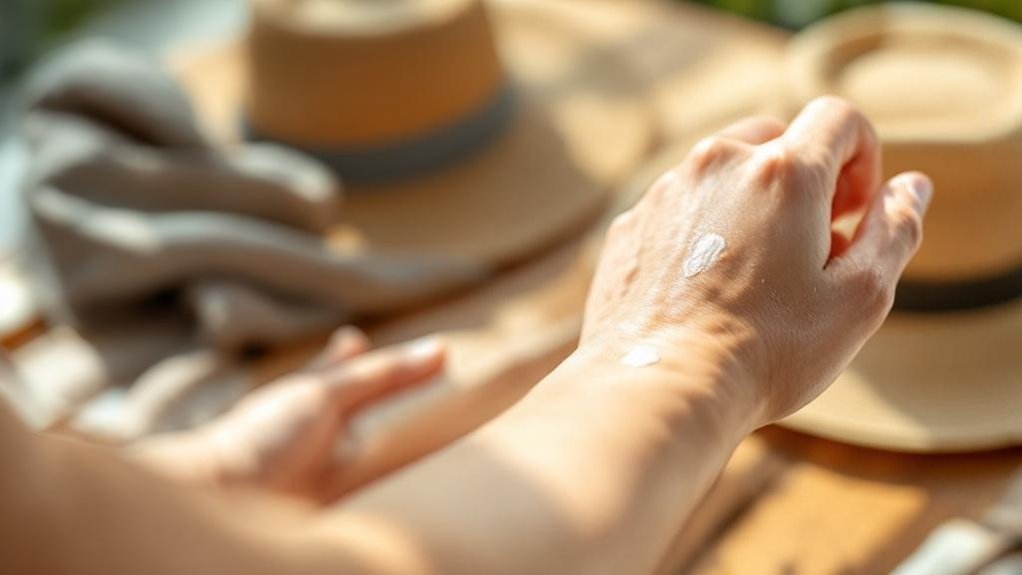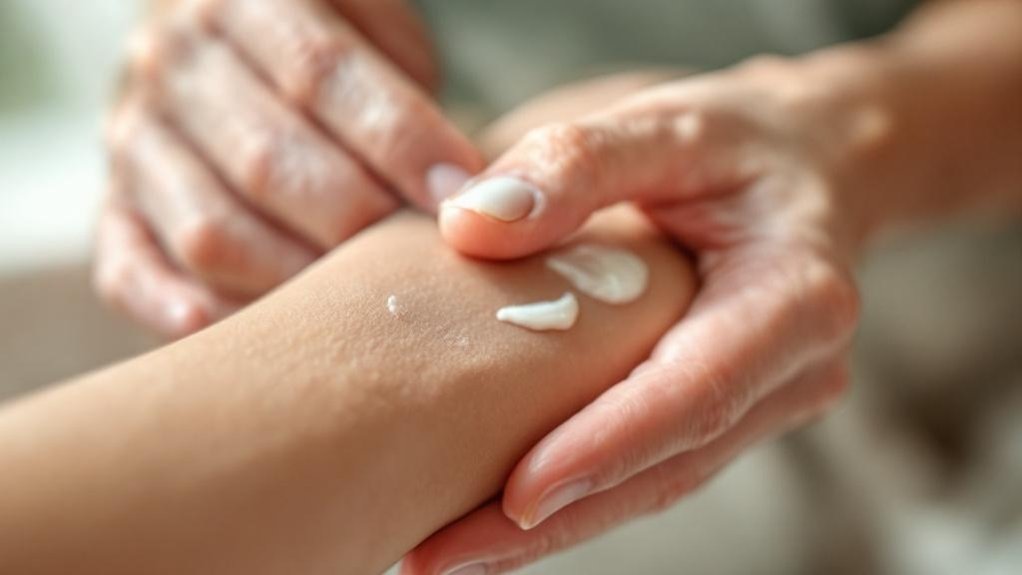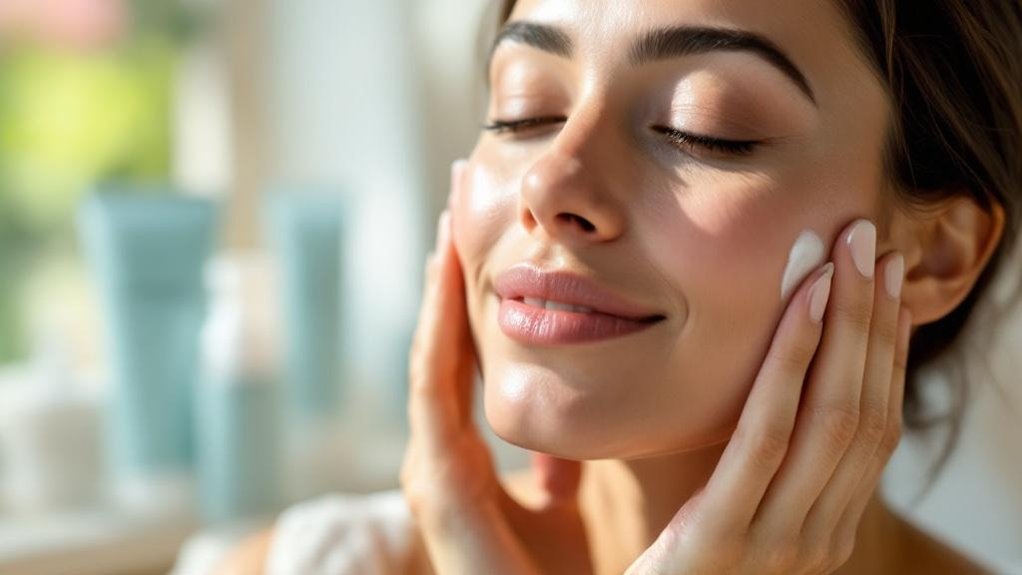Posted by: Skin And Cancer Institute in Skin Cancer

Skin cancer post-radiation treatment, your skin needs lifelong protection. Apply fragrance-free moisturizers daily, use SPF 50+ sunscreen year-round, and reapply every two hours when outdoors. Wear UPF 50+ clothing and conduct monthly self-examinations of treated areas. Watch for unusual lesions or shiny bumps requiring immediate medical attention. Radiation-treated skin remains permanently vulnerable to UV damage, increasing secondary cancer risks that proper management can greatly reduce.
Key Takeaways
- Apply a broad-spectrum SPF 50 sunscreen daily on treated areas and reapply every two hours when outdoors.
- Use gentle, fragrance-free cleansers and medical-grade moisturizers designed for compromised skin barriers.
- Perform monthly self-examinations of treated skin and seek immediate medical attention for unusual lesions.
- Wear UPF 50+ protective clothing and seek shade between 10 AM and 4 PM.
- Incorporate antioxidant-rich foods in your diet to complement external protection strategies.
Understanding the Long-Term Risks to Radiation-Treated Skin

While radiation therapy serves as an essential treatment modality for many cancers, we must acknowledge the considerable long-term risks it poses to treated skin. Patients who’ve undergone radiation therapy face an elevated risk of developing secondary skin cancers within the treated areas, with standardized incidence ratios reaching 5.2 for basal cell carcinoma and dramatically increasing to 15.9 after 35 years.
Radiation effects extend beyond cancer risk. Treated skin undergoes permanent changes—developing a darker appearance resembling a permanent suntan, increased sun sensitivity, telangiectasia (red spidery marks from broken blood vessels), and altered texture. Additionally, patients may experience chronic radiation dermatitis manifesting as wounds, ulcerations, and fibrosis. The risk factors for developing these complications include radiotherapy dose and fractionation, as well as concurrent systemic therapy. Superficial Radiation Therapy (SRT) offers an alternative with minimal side effects compared to traditional radiation approaches, typically causing only temporary redness and flaking. These complications considerably impact quality of life and require vigilant monitoring and specialized care from our dermatology team.
Essential Daily Skincare for Previously Irradiated Areas
We recommend using pH-balanced, fragrance-free cleansers on radiation-treated skin to avoid triggering inflammation or irritation. Follow cleansing with immediate application of medical-grade moisturizers specifically formulated for compromised skin barriers. These products should be free from alcohol, perfumes, and potential sensitizers that could disrupt the healing process in vulnerable post-radiation tissue. Wear soft, loose clothing to minimize friction against sensitive treated areas. Regular skin assessments are crucial to monitor healing progress and detect any concerning changes that might require medical attention.
Gentle Cleansing Products
Selecting the right cleansing products represents one of the most essential steps in caring for skin that has undergone radiation therapy. We recommend pH-balanced formulations (around 5) that support your skin’s natural barrier function, as basic or neutral pH cleansers can disrupt healing.
Choose fragrance-free, hypoallergenic options like Cetaphil, Vanicream, or La Roche-Posay. Brands such as Dove® and Basis® have proven particularly effective for post-radiation care. Cream-based cleansers with lipid-replenishing ingredients provide superior gentleness.
When cleansing, use only your hands with a gentle splashing motion—never washcloths or loofahs. Apply with warm water, rinse thoroughly, and pat dry rather than rubbing. Post-treatment skin requires extra care due to its increased sensitivity and susceptibility to damage. For scalp areas, mild baby shampoo formulations work well. Always verify products are dermatologist-tested and approved by your cancer care team.
Moisturize Without Irritation
Because radiation therapy considerably compromises skin integrity, proper moisturization becomes essential for recovery and long-term health. We recommend thin applications (1-2mm) of ointment-based moisturizers, which cause less irritation and provide deeper hydration than creams or lotions. Trusted options include Aveeno, Cetaphil, and Eucerin Original.
For application techniques, use gentle hand motions daily on intact skin, avoiding open wounds or damaged areas. You can safely apply moisturizer regardless of timing relative to radiation sessions. The consistent hydration helps reduce severity and delay onset of radiation dermatitis, particularly important as skin moisture decreases with cumulative radiation doses. A proper moisturizing routine significantly contributes to less severe dermatitis and later onset of radiation-induced skin reactions.
For specialized concerns, we may recommend silicone-based products for scar tissue or Medihoney for dry desquamation. Remember, properly moisturized skin recovers more quickly from radiation treatment.
Sun Protection Strategies That Last a Lifetime

We recommend implementing lifelong UV protection through broad-spectrum SPF 50 sunscreen application to all previously irradiated skin areas. Your daily defense should include multiple protective layers: sunscreen reapplied every two hours, UV-protective clothing with UPF 50+ rating, and wide-brimmed hats that shield high-risk facial regions. High-risk areas—including the scalp, ears, and back of neck—require special attention with targeted sunscreen formulations and physical barriers to prevent radiation-related secondary malignancies. Be especially vigilant when visiting higher elevation areas, as UV exposure increases 4-10% per 1,000 feet of elevation. Scheduling regular follow-ups with your dermatologist every three to six months can significantly improve early detection of any skin changes.
Lifetime UV Protection Essentials
Patients who have undergone radiation therapy must adopt extensive UV protection strategies that extend throughout their lifetime. These patients require professional-grade sunscreens with minimum SPF 30, though we recommend SPF 50 with broad-spectrum protection against both UVA and UVB radiation.
Physical barriers provide constant protection where sunscreen ingredients may fail. UPF-rated clothing, wide-brimmed hats, and UV-blocking sunglasses should become daily essentials, not occasional precautions. Using a close weave cotton fabric offers excellent natural protection against harmful rays.
We advise strategic sun avoidance between 10 a.m. and 2 p.m., along with seeking shade whenever possible. Remember, UVA radiation remains constant throughout the day, requiring vigilance regardless of time.
Maintaining regular dermatological follow-ups every 3-6 months and performing monthly self-examinations are vital components of your long-term protection plan. Together, we’ll help you maintain these protective measures as permanent lifestyle changes.
Layer Your Defense Daily
Protecting radiation-treated skin requires implementing multiple defensive layers that work together to provide extensive UV protection. We recommend establishing daily habits that include wearing loose-fitting, tightly woven clothing in darker colors to maximize coverage and protection.
Your protective routines should combine strategic shade-seeking during peak UV hours (10 a.m. to 2 p.m.) with consistent application of broad-spectrum SPF 30+ sunscreen. Remember, even in shade, UV rays reflect off surfaces like water and sand. Apply 3-4 tablespoons of sunscreen for full-body coverage and reapply every two hours or after swimming and sweating.
Complete your defense system with wide-brimmed hats and wraparound sunglasses that block 100% of UV-A and UV-B rays. This multi-barrier approach provides the extensive protection your radiation-treated skin needs. After radiation therapy, continue to avoid tanning beds as they emit harmful UV rays that can further damage your healing skin.
High-Risk Area Coverage
For cancer survivors, certain body regions demand heightened vigilance and specialized protection following radiation therapy. Head, neck, and face areas account for most recurrent lesions due to thinner skin and constant sun exposure.
Areas previously treated with radiation require extraordinary care, showing 5-10 times higher risk for secondary cancers. Scalp and ears become particularly vulnerable in those with thinning hair, while extremities need consistent coverage during outdoor activities. UV rays can still cause significant damage even on cloudy days, so year-round protection is essential.
When protecting these high-risk locations, we recommend physical barrier sunscreens with zinc oxide for radiation-damaged skin. UPF 50+ clothing provides 98% UV blockage for exposed areas. Remember that environmental factors amplify risk—water reflects 15% of UV rays, while snow reflection increases exposure by up to 80%.
Monthly self-examinations focusing on previously treated areas remain essential for early detection of suspicious changes.
Selecting Proper Clothing and Physical Barriers

When choosing clothing after radiation treatment, understanding UPF ratings becomes essential for proper skin protection. We recommend selecting fabrics with UPF 50+, which block 98% of harmful UV rays—considerably more than a standard cotton T-shirt that offers only UPF 5.
For ideal protection, choose clothing types that maximize coverage: long-sleeved shirts, long pants, and wide-brimmed hats that shield your face, ears, and neck. Fabric choices matter greatly—dark colors and tightly woven materials provide superior protection. Unlike sunscreen, sun-protective clothing never needs to be reapplied and provides consistent defense throughout the day. Look for synthetic fibers like polyester or specially treated sun-protective clothing that maintains its UPF rating even when wet.
Remember that physical barriers offer consistent protection without reapplication. For enhanced protection of existing garments, consider specialized laundry detergents containing UV-absorbing crystals that can increase your clothing’s protective qualities. These barriers are especially important between 10 a.m. and 4 p.m. when UV radiation is at its strongest intensity.
Warning Signs: When to Contact Your Dermatologist
While physical protection is essential, monitoring your skin for concerning changes remains equally important.
As skin cancer awareness experts, we recommend immediate dermatologist consultations for any non-healing sores or ulcers persisting beyond four weeks, especially in previously treated areas. Contact us promptly about new shiny, pearly bumps, flat or raised lesions with unusual coloring, or itchy red patches that don’t resolve. Concerning signs include painful, weeping skin with infection indicators, sudden swelling in radiation fields, or unexplained bruising in treated areas.
Be vigilant about delayed radiation effects such as persistent itching, skin thickening, or visible spider veins months after treatment. Northern California residents should schedule annual screenings due to higher UV radiation levels throughout the region. Over 90% of radiation therapy patients experience some form of radiation dermatitis during or after treatment. If moisturizers fail to alleviate dryness within 7-10 days or if you experience intensifying pain despite standard care, we’re here to help at (888) 993-3761.
Managing Delayed Skin Reactions and Discomfort

Although many patients focus on immediate skin reactions during radiation therapy, delayed effects often present more challenging long-term management issues. These chronic reactions can appear months or even years after treatment completion, progressing gradually and often irreversibly.
At the Skin and Cancer Institute, we recognize that symptom management for delayed reactions requires specialized approaches. When patients notice recurring redness, increasing fibrosis, or new telangiectasia in previously treated areas, prompt evaluation is essential. Research shows that late adverse effects don’t follow a Gaussian distribution, indicating different biological mechanisms from acute reactions. We tailor treatment protocols based on reaction severity, genetic factors, and treatment history.
Remember that skin-on-skin contact areas and high-dose radiation zones face elevated risk for chronic complications. Superficial radiation techniques can help minimize these long-term effects by targeting only the top layers of skin while preserving surrounding healthy tissue. We’re committed to helping you navigate these delayed reactions with evidence-based interventions that maintain your quality of life throughout the recovery journey.
Building Your Medical Support Team for Ongoing Monitoring
Establishing a thorough medical support team remains critical for ideal post-radiation skin monitoring and long-term health maintenance. We recommend coordinating care between your radiation oncologist, dermatologist, and primary care physician for extensive follow-up every six to twelve months.
Your radiation oncologist monitors treatment effectiveness, while dermatologists provide specialized skin cancer surveillance. Oncology nurses assist with side effect management, and medical oncologists may join the team for melanoma patients facing higher recurrence risks. Regular monitoring is crucial as most patients experience skin irritation effects that gradually improve over time following radiation therapy.
We’ve found that patients who engage with support groups and practice patient advocacy experience better outcomes. These connections provide both emotional support and practical knowledge for maneuvering the healthcare system. Scheduling check-ups during spring months can help establish a consistent pattern for seasonal skin assessments. Confirm direct communication channels with your providers to promptly report even minor skin changes, as early intervention prevents complications and supports long-term recovery.
Specialized Products for Radiation-Affected Skin

Selecting appropriate skincare products for radiation-affected skin requires careful consideration of ingredients, formulations, and application methods. We recommend petroleum-based barrier creams like Aquaphor, Eucerin, or Vaseline that provide protection while allowing healing.
For immediate cooling relief, hydrogel products such as Lindi Skin Cooler Rolls and Pads deliver soothing comfort with natural ingredients like aloe and green tea. These specialized formulations target radiation dermatitis symptoms effectively, a common and painful condition experienced during radiation therapy.
In more severe cases, prescription options including triamcinolone 0.1% or mometasone furoate creams may be necessary. For gentler approaches, we suggest alcohol-free pure aloe gel or Dermavitality’s organic products.
Remember to avoid scented creams, Desitin, and medicated ointments unless specifically prescribed. Always consult with our dermatology team before applying any product to radiation-treated skin.
Lifestyle Modifications to Minimize Future Skin Cancer Risk
After radiation treatment, patients must implement thorough lifestyle modifications to minimize future skin cancer risk. We recommend daily application of broad-spectrum SPF 30+ sunscreen even on cloudy days, with reapplication every two hours during outdoor activities.
Complete avoidance of tanning beds is essential, as they increase melanoma risk by 75%. Incorporate protective clothing—broad-brimmed hats and UV-blocking sunglasses—and seek shade between 10 AM and 4 PM when UV rays are strongest. Pay special attention to reflective surfaces that can significantly amplify UV exposure, such as water, sand, and snow.
Monthly self-examinations and annual professional skin checks are critical for early detection. Las Vegas residents should be particularly vigilant given the city’s 320+ sunny days annually, which significantly increases UV radiation exposure. Lifestyle changes should include incorporating dietary antioxidants through whole foods rather than supplements, which research shows provides better protection. These nutritional approaches complement traditional sun protection strategies for extensive risk reduction.
At Skin and Cancer Institute, we’re committed to supporting your post-treatment journey with expert guidance.
Frequently Asked Questions
Can I Get Tattoos on Previously Radiated Skin?
We don’t recommend tattoos on radiated skin. The tissue remains vulnerable with compromised healing ability. Tattoo safety concerns include increased infection risk and potential ink interactions with previously treated areas.
How Long After Radiation Can I Resume Using Retinol Products?
We recommend waiting 4-6 weeks after radiation before resuming retinol products. Your skin sensitivity requires medical clearance first. We’ll assess your skin’s healing status during your follow-up appointment.
Does Radiation Treatment Affect How My Skin Reacts to Insect Bites?
Yes, radiation treatment markedly increases skin sensitivity, causing enhanced insect bite reactions. We often see more severe inflammation, longer healing times, and increased risk of infection in treated areas.
Will Previous Radiation Make Laser Hair Removal Unsafe?
Yes, previous radiation can make laser hair removal unsafe due to increased skin sensitivity. We’ll need your oncologist’s clearance and medical records before proceeding with any laser hair safety protocols.
Can Radiation-Treated Skin Safely Handle At-Home Microneedling Devices?
We don’t recommend at-home microneedling on radiation-treated skin. Your skin healing capacity is greatly compromised after radiation, increasing infection risks. Please consult with our dermatologists for safe alternatives.
Conclusion
We’ve seen how proper post-radiation care greatly improves long-term outcomes. With consistent sun protection, appropriate skincare products, and regular dermatological monitoring, you’re taking essential steps to protect your skin’s future health. Don’t hesitate to contact us if you notice any changes in your treated areas. Remember, we’re partners in your ongoing skin health journey, committed to helping you maintain your victory over skin cancer.